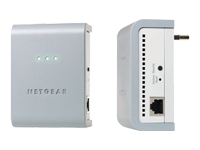I used to run ethernet cables all over the house... I would star them from a central location where I had adequate ventilation / power for my devices... then I realized that the (Cat5e) results I got didn't justify the time and pain of fishing things around tight areas in the house (attracting sweaty globs of insulation all over my body)...
I have been using HomePlug AV to replace physical ethernet wires with very good success. As long as your power circuits between your endpoints meet the basic requirements1, you should see between 30 - 70Mbps through your power circuits using HomePlug AV 2. The devices I use are made by NetGear, but you could choose pretty much any one that you feel comfortable with; I read reviews on Newegg to filter products like this.
Your total cost out the door to start with a single HomePlugAV connection is about $100; that buys you a pair of the transceivers (equivalent of running one wire). Afterwards, you can incrementally expand in multipoint ethernet fashion on the same electrical phase by buying one more HomePlugAV transceiver for about $50/ea.
A single transceiver looks like this (front / side views)...

EDIT
In response to Lisa's comment, I will add this bit about my experiences with Homeplug AV...
I have been using Homeplug AV ever since the first commercial implementation shipped on the Zyxel PLA-400 (v1) in 2007. I started using Homeplug AV because I was getting frustrated with 802.11g and unreliable connections; this was in a residential neighborhood and I was only 60 feet from the wifi source (WRT54GL running at max signal strength). As a network engineer, I have very high expectations for reliability, and HomeplugAV has not disappointed at all. I routinely keep ssh and VNC sessions up for months through HomeplugAV links3. The technology uses Forward Error Correction with OFDM, and my apps are all TCP... I have never had a reliability issue, even when the washing machine, vacuum cleaner, or power tools operate on the same AC circuit4. That said, I have never streamed UDP video through this, and that truly would be a different use case.
End-Notes:
The issue that stands the biggest chance of being a problem is if you want to transmit a single HomePlug AV connection across two different electrical phases in the house. If you need to bridge the electrical phases with HomePlug AV, use an ethernet switch fed by HomeplugAV transceivers connected to the two phases. Also be sure you do not plug a HomePlug AV device into a UPS or surge protector... they are only designed to go on basic electrical wall outlets.
Don't believe numbers larger than 70Mbs for HomePlug AV... there is a lot of unusable-bit-count marketing involved in most of the Homplug AV products.
In four years of use, I can only remember dropping one TCP session across Homeplug AV, every other time TCP sockets are manually terminated by me (since there was only one drop I am not 100% sure this can be blamed on HomeplugAV). I immediately restarted the session, and have not had another problem.
Initially I used it through 2-wire romex laid in the 1950s; after I sold that house, I used it in an apartment complex with similarly stellar results (using Netgear transceivers, as my original Zyxel PLA-400 croaked after about 3-years). While some might gripe about replacing the transceiver after three years, I am (so far) not concerned; that Zyxel was literally one of the first units they shipped. I ordered it off NewEgg as soon as they released it.



